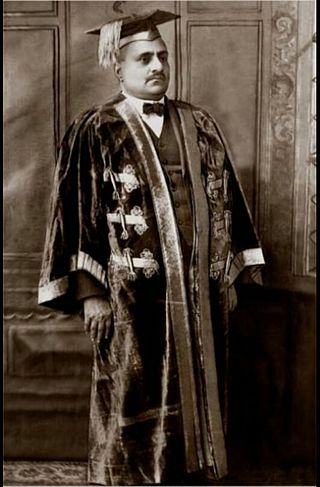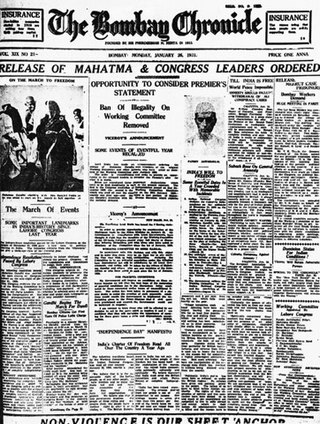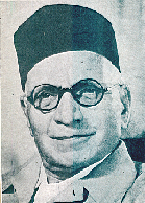
The Chitpavan Brahmin or the Kokanastha Brahmin is a Hindu Maharashtrian Brahmin community inhabiting Konkan, the coastal region of the state of Maharashtra. Initially working as messengers and spies in the late seventeenth century, the community came into prominence during the 18th century when the heirs of Peshwa from the Bhat family of Balaji Vishwanath became the de facto rulers of the Maratha empire. Until the 18th century, the Chitpavans were held in low esteem by the Deshastha, the older established Brahmin community of Karnataka-Maharashtra region.

Seshadri Srinivasa Iyengar CIE, also seen as Sreenivasa Iyengar and Srinivasa Ayyangar, was an Indian lawyer, freedom-fighter and politician from the Indian National Congress. Iyengar was the Advocate-General of Madras Presidency from 1916 to 1920. He also served as a member of the bar council from 1912 to 1920, the law member of Madras Presidency from 1916 to 1920 and as the president of the madras province Swarajya Party faction of the Indian National Congress from 1923 to 1930. Srinivasa Iyengar was the son-in-law of renowned lawyer and first Indian Advocate-general of Madras, Sir Vembaukum Bhashyam Aiyangar. Iyengar's followers called him Lion of the South.

Anugrah Narayan Sinha, known as Bihar Vibhuti, was an Indian nationalist statesman, participant in Champaran Satyagraha, Gandhian & one of the architects of modern Bihar, who was the first Deputy Chief Minister and the Finance Minister of the Indian state of Bihar (1946–1957). He was also a Member of the Constituent Assembly of India, which was elected to write the Constitution of India and served in its first Parliament as an independent nation. He also held a range of portfolios including Labour, Local Self Government, Public Works, Supply & Price Control, Health and Agriculture. A.N. Sinha, affectionately called Anugrah Babu, was a very close associate of Mahatma Gandhi during the freedom struggle movement and worked with Bihar Kesari Sri Krishna Sinha to lead the Gandhian movement in Bihar. One of the leading nationalists in the Indian independence movement from Bihar after Dr Rajendra Prasad, he was elected as the Congress Party deputy leader in the state assembly to assume office as first Deputy Chief Minister cum Finance Minister of independent Bihar, and re-elected when the Congress Party won Bihar's first general election with a massive mandate in 1952.

Sir Hari Singh Gour was a distinguished lawyer, jurist, educationist, social reformer, poet, and novelist. Gour was the First Vice-Chancellor of the University of Delhi and Nagpur University, founder and Vice-Chancellor of the University of Sagar, Deputy President of the Central Legislative Assembly of British India, an Indian Delegate to the Joint Parliamentary Committee, a Member of the Indian Central Committee associated with the Royal Commission on the Indian Constitution, and a Fellow of the Royal Society of Literature.
Indo-Asian News Service or IANS is a private Indian news agency. It was founded in 1986 by Indian American publisher Gopal Raju as the "India Abroad News Service" and later renamed. Their main offices are located in Noida, Uttar Pradesh. The service reports news, views and analysis from the subcontinent about the country, across a wide range of subjects, to subscribers via the Internet.

The Bombay Chronicle was an English-language newspaper, published from Mumbai, started in 1910 by Sir Pherozeshah Mehta (1845-1915), a prominent lawyer, who later became the president of the Indian National Congress in 1890, and a member of the Bombay Legislative Council in 1893. J. B. Petit had assisted Mehta in launching the newspaper and later went on to control the Indian Daily Mail. From 1913 to 1919 it was edited by B. G. Horniman.
Jhala is a Rajput clan. They are found in Rajasthan and Gujarat state of India. The clan is also found among Koli castes as Jala.

Mukund Ramrao Jayakar was an Indian Lawyer, scholar and politician. He was the first Vice-Chancellor of the University of Poona. He was also a prominent freedom fighter.

Neill statue Satyagraha was an agitation that took place in Madras Presidency, British India during the Indian Independence Movement. It took place in 1927 demanding the removal of the statue of Colonel James Neill situated at Mount Road in Madras.
The Free Press Journal is an Indian English-language daily newspaper that was established in 1928 by Swaminathan Sadanand, who also acted as its first editor. First produced to complement a news agency, the Free Press of India, it was a supporter of the Independence movement. It is published in Mumbai, India.
Swaminathan Sadanand (1900–1953) was an Indian journalist.
The Responsive Cooperation Party was a political party operating in the Indian independence movement and was established by M. R. Jayakar, B. S. Moonje, N. C. Kelkar and others. The party was a splinter from the Motilal Nehru-led Swaraj Party, which was further split by the formation of the Independent Congress Party and the Nationalist Party. The Responsive Cooperationists had become opposed to the concept of non-cooperation with the government of the British Raj and Jayakar's move away from the Swaraj Party was evident by October 1925. The concept of responsive cooperation predates the party and was coined by Joseph Baptista, before being taken up by Bal Gangadhar Tilak, of whom Kelkar was a follower, around 1919.

Navshakti is a Marathi newspaper based in Mumbai, India. The newspaper has a circulation of 83,910 across the state of Maharashtra. This paper was started by S. Sadanand. P. R. Behere was its first editor.
The Independent was an Allahabad based newspaper begun by Motilal Nehru in 1919. The paper closed down under British repression two years later.
Premlila Vithaldas, (1894–1977) known as Lady Thackersey, was an Indian educationist and Gandhian.
Jehangir Bomanji Petit was a noted nationalist, mill owner, philanthropist, and one of Mahatma Gandhi's earliest supporters.

United News of India, abbreviated as UNI, is a multilingual news agency in India. It was founded On 19 December 1959 as an English news agency. Its commercial operations were started from 21 March 1961. With its Univarta, a Hindi news service, UNI became one of the multilingual news service in the world. In 1992, it started its Urdu news service and hence became the first news agency to provide Urdu news. Currently, it is the second largest news agency in India, supplying news in English, Hindi, Urdu and Kannada languages. Its news bureaus are present in all state capitals and major cities of India.

Kuntala Kumari Sabat (1901–1938) was an Odia poet during colonial India. She was one of the women poets who came into prominence from Odisha during India's freedom struggle. She was multifaceted personality. She was a physician, writer, poet, editor, leader of nationalist movement and social worker. She was honored with Utkala Bharati in 1925.

The Mylapore clique or oligarchy was a small coterie, amounting to a "handful" of politically moderate, elite Brahmins, many of them noted lawyers, administrators, academics or educators, or industrialists, in the Madras Presidency, who 'wielded almost exclusive influence and patronage in the service and government appointments', 'controlled the flow of resources out of the institutions of the capital' and 'dominated the professional and political life of [the presidency].' Informal and exclusive, it was historically controlled by two extended families, the Vembaukum Iyengars, and the Calamur Viravalli-Chetpet Iyers, and took its name from the luxurious Madras City neighborhood in which many leading members kept mansions. The clique coalesced and began its dominance in the 1880s and 1890s under the headship of Sir V. Bhashyam Aiyangar and Sir S. Subramania Iyer, with R. Raghunatha Rao as a tertiary leader; while some argue that it reached its zenith between 1910 and 1920, others highlight its remarkable successes in ministry and magistracy continuing in the 1920s and 1930s, with Sir C. P. Ramaswami Iyer as leader.
Konnanath Ramakrishna Menon, known widely as K.R.K. Menon, was the first Finance Secretary of independent India, charged with oversight of Indian Revenue. He further held the offices of Chairman of the Central Board of Revenue, Chairman of the Industrial Finance Corporation of India (IFCI), and Chairman of the Kerala State Industrial Development Corporation, and served as a member of the Planning Commission (India), Administrative Reforms Commission, and as a Governor on the Board of the Indian Institutes of Technology (IIT).









